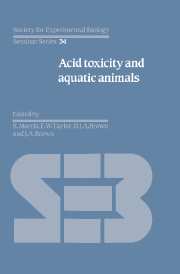Book contents
- Frontmatter
- Contents
- Contributors
- Units, Symbols and Formulae
- Preface
- Introduction: The causes and consequences of surface water acidification
- Invertebrate communities in acid streams
- Fish survival in acid waters
- Field studies on fisheries in acid waters in the UK
- Episodic changes in water quality and their effects on fish
- Acid–base regulation in fishes: 1. Mechanisms
- Acid–base regulation in fishes: 2. Biological responses and limitations
- Intracellular pH regulation and the effects of external acidification
- The physiological problems of fish in acid waters
- Laboratory studies on invertebrate survival and physiology in acid waters
- The physiological problems of crayfish in acid waters
- The effects of hydrogen and aluminium ions on fish gills
- The combined effects of pH and trace metals on fish ionoregulation
- Endocrine responses to acid stress in fish
- Commentary and conclusions
- Index
Episodic changes in water quality and their effects on fish
Published online by Cambridge University Press: 05 February 2012
- Frontmatter
- Contents
- Contributors
- Units, Symbols and Formulae
- Preface
- Introduction: The causes and consequences of surface water acidification
- Invertebrate communities in acid streams
- Fish survival in acid waters
- Field studies on fisheries in acid waters in the UK
- Episodic changes in water quality and their effects on fish
- Acid–base regulation in fishes: 1. Mechanisms
- Acid–base regulation in fishes: 2. Biological responses and limitations
- Intracellular pH regulation and the effects of external acidification
- The physiological problems of fish in acid waters
- Laboratory studies on invertebrate survival and physiology in acid waters
- The physiological problems of crayfish in acid waters
- The effects of hydrogen and aluminium ions on fish gills
- The combined effects of pH and trace metals on fish ionoregulation
- Endocrine responses to acid stress in fish
- Commentary and conclusions
- Index
Summary
Introduction
The areas of North America and Northern Europe from which decline of fish populations in acid waters (pH ≤5.6) has been reported are usually characterised by high levels of precipitation and by weathering-resistant bedrock, resulting in poor soils and surface waters very low in dissolved substances ([Ca] ≤100 μmol l-1, 4 mg l-1; conductivity ≤60 μS cm-1) (reviews: Haines, 1981; Spry et al., 1981; Harvey, 1982; Harvey & Lee, 1982; Howells, 1983; see also papers in this volume by Brown & Sadler; Mason; Turnpenny).
The streams and lakes in these predominantly mountainous areas are, consequently, vulnerable to rapid and large changes in their chemistry. The soil may frequently be waterlogged or frozen, and may be thin or absent altogether (at bedrock outcrops and scree slopes). Episodes of heavy rainfall or snowmelt may therefore result in more or less direct runoff into the water bodies. The low concentration of dissolved substances in the water bodies ensures that the ability to buffer changes in acidity is poor, and concentration changes caused by runoff episodes are likely to be relatively large. The pH of the water may fall dramatically during such episodes (Tables 1, 2).
From time to time, fishkills (particularly of Salmonidae) are observed in such waters (Table 2), occurring over short periods (hours or days) and coinciding with increased water discharge associated with heavy rain, snowmelt or release of artificially impounded water.
- Type
- Chapter
- Information
- Acid Toxicity and Aquatic Animals , pp. 67 - 84Publisher: Cambridge University PressPrint publication year: 1989
- 17
- Cited by



